As I discussed in my previous article, the idea that there is a direct, linear relationship between science and technology, also known as the “assembly line” model favored by policymakers (Kline, 1995), though often taken for granted in videogame mechanics, doesn’t stand up to even a passing glance at history. Of course, this is not to say that science and technology have no relationship to each other. There are many points throughout history where the two intersect. The development of scientific instruments, for example, required the material knowledge of craftsmen like glassmakers. Scientists needed the level of precision these technologies provided in order to make scientific claims. This, in turn, pushed technologists to refine their methods to achieve even more accuracy and precision (Kuhn, 1962).
This desultory interplay of scientific inquiry and the useful arts was the norm throughout most of human history. Ironically, it was the professionalization of these two rather nebulous fields into the inflexible definitions of “science” and “technology” as that we understand today that problematized their relationship. Bruno Latour (1987) argues that as the concept of science became restricted to the professional academic scientists in a cloistered lab setting, these scientists became ever more dependent upon large social and economic networks to lay the groundwork that empowers them to produce knowledge. Paradoxically, as the definition of who was considered to be a scientist grew ever more restrictive, the number of actual people involved in and, indeed, necessary for scientific work grew far beyond the confines of the lab.
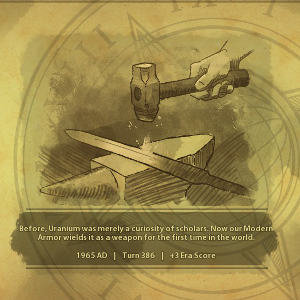
Latour argues that what we understand as “science and technology” is an illusion that doesn’t reflect the actual work being done. Rather, it reflects the way in which our society values different kinds of work. Instead of trying to refer to the two fields as distinct enterprises, he suggests the term “technoscience” to more accurately capture the material, economic, and political networks that are part of the scientific endeavor.
Technoscience is a term I’ve used occasionally on this site, particularly in reference to the kinds of knowledge represented in tech trees, though without delving too deeply into its implications. As noted in the preceding article, the model of science and technology as two complementary and inexorably linked pieces of the military-industrial complex does a poor job of representing actual scientific and technological developments prior to the twentieth century. Technoscience, then, according to Donna Haraway (1997), is a “mutation in historical narrative.” For Haraway, the concept of technoscience underscores the implosion of the supposedly stable categories that structure the modern world. Technoscience rejects modernity’s rigid distinctions between the scientific and the social, the technical and the political.
Other scholars have further developed the concept of technoscience. Karen Barad (2007) notes that human practices are not the only ones that matter in technoscientific networks. In order for new knowledge to be constructed, a vast infrastructure must be created both materially and rhetorically (Latour, 1987). Thus, scientific work isn’t just the actions of scientists in white lab coats. Knowledge production requires that the work of countless other non-scientists be brought into the network. It requires the work of engineers and technicians building equipment, as well as administrators and support staff securing resources. The network also must be able to enroll material elements. This includes not only basic resources and scientific instruments, but also natural phenomena as objects of study. Their inclusion isn’t trivial or guaranteed. Scientists often discover, as Barad would say, “the world kicks back” (Barad, 2007).

Just as videogames often struggle to conceptualize science and technology in nuanced ways, they also struggle to represent the intersections of science and technology which, besides just being complex, have changed drastically over the past 150 years. This is not a shortcoming of the medium. Indeed, with their ability to model complex systems for players to interact with, videogames are perhaps uniquely suited to portraying complex ideas like technoscience in a way that players can understand. Some games, of course, come closer to this aspirational goal than others. Once again, the Civilization series provides some excellent examples of both ends of the spectrum.
Returning to RULES.TXT, the file from Civilization II that gathered all the main game mechanics into a single location for ease of modding, we can get a good idea of how the developers conceptualized science and technology. The general concept of “technology” in Civ II is fairly broad, encompassing social technologies like labor unions along side academic knowledge like atomic theory. When it comes to actual scientific work, however, its conceptualization is much narrower. There are only three ways to increase the base level of science set by the player’s tax rate. The first is to build science buildings: Libraries, universities, and labs. The second is to assign citizens to work as scientists. The third is to build certain world wonders like Copernicus’ Observatory (which are basically just unique examples of traditional scientific buildings). Knowledge production doesn’t occur in any other way. Even though both communism and labor unions, for example, are considered technologies within the game’s framework, none of the knowledge that goes into these developments comes from labor occurring in factories. Just as with physics or genetic engineering, these developments must be wholly created from the knowledge created in academic settings.
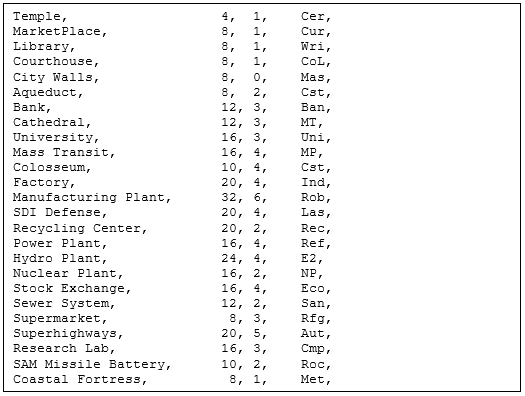
Even for modders, there is little flexibility in the representation of scientific work. Looking at the section of the file containing the rules for buildings, we see a number of attributes that can be modified. A modder could rename a building or change its cost to build, but there will always be three dedicated science buildings and no other form of knowledge production. This would remain the model for many of the games in the series.
The first game to meaningfully deviate from this model was Civilization V, which removed more social concepts like monarchy and military tradition from the tech tree and placed them into a similar, parallel progress system for “culture,” which was generated by buildings like museums, amphitheaters, and broadcast towers. On the one hand, this sharp dichotomy between scientific and non-scientific knowledge production in many ways reinforces the modernist distinctions that Latour, Haraway, and Barad critique. However, it can also be seen as a first step in legitimating other models of knowledge production without simply pigeonholing them into the positivist framework of “scientific progress.”
Perhaps more significantly, Civilization V gives us a much broader representation of how scientific knowledge is generated. In addition to being generated by scientists and scientific buildings, science is generated by trade routes that travel to other civilizations, by founding a city near a natural wonder like the great barrier reef, or by having citizens work in the jungles near a university. The new social policies system, while represented as being distinct from science, is nonetheless intertwined in scientific work in other ways. Many social policies allow science to be created at non-scientific buildings like banks or trading posts. In fact, one whole policy tree deals with a belief in rationalism, which contains many policies that benefit scientific production in one way or another. The idea that scientific work is enabled by the social actions of non-scientists in many ways resembles Latour’s concept of scientists mobilizing an “outside” workforce of administrators, financiers, and engineers that lay the groundwork for the scientists “inside” the the labs to make the strong rhetorical statements that are required to articulate facts (Latour, 1987)
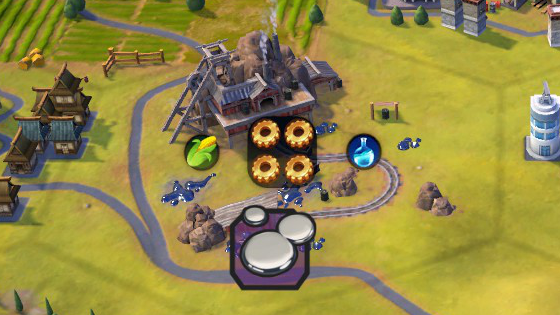
This elaboration of scientific work continued in Civilization VI, which added even more ways to generate science. Certain resources on land tiles now generate science when worked, which means that citizens who work in an iron mine or on a tea plantation now generate science along with their other products. Aquariums, which are primarily entertainment buildings, also generate science.
We can see these changes by comparing the rules for buildings in Civilization II found in RULES.TXT with the corresponding rules in Civilization VI, found in the file Buildings.xml.
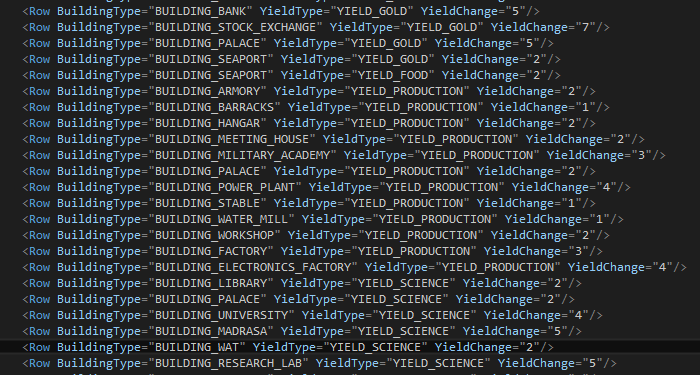
One of the most obvious changes to occur over the course of the twenty years between Civ II and Civ VI is the development of more sophisticated programming techniques and standards. Instead of storing data in a simple text file, Civ V uses XML files, which, though still comprised of human-readable text, have a hierarchical, structure defined through a markup language. This is advantageous in numerous ways for both the developers and modders, as well as for researchers like me.
Another notable change is the increase in size and complexity. While Civilization II contained basically all its core rules in a single 27 kB file, the corresponding data in Civilization VI spans across 87 files, totaling 3.15 MB of data, 117 times more than Civ II. Since more recent Civ games must be downloaded (even if you buy the box), they’re not constrained by the size of floppy disks or CD-ROMs, giving the developers considerably more freedom to shape the game world how they see fit. These technical changes, however, aren’t what’s interesting about Civ VI’s code, it’s what the developers do with this new freedom that interests me. The changes they made reflect a more nuanced model of science and scientific work, expanding it beyond exclusively academic labor.
Looking more closely at these lines of code, several changes become apparent. A single building can be mentioned multiple times, thus having multiple values for its YieldType. The Seaport, for example, produces both gold and food, and the wat, a religious building, produces two units of science along with its normal yield of faith.
Perhaps the most notable change in the way that science works in Civilization VI is that nearly every technology on the tree now has a boost or “eureka moment” associated with some material or social condition. For example, the player receives a boost toward the discovery of writing once she encounters another civilization, essentially cutting the amount of research required for the technology in half. The discovery of masonry is now boosted when the player builds her first quarry. Twenty-five years after the first Civ game, masonry is finally being discovered by the people making bricks, rather than by wise men musing in a marble laboratory.
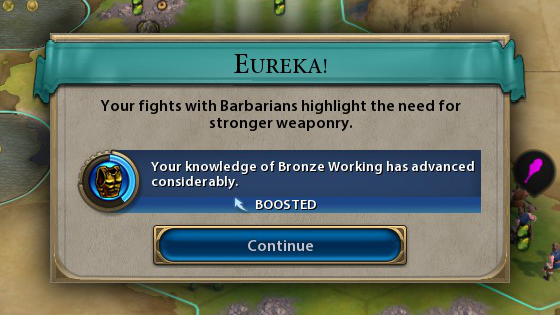
Of course, within the game world, these material components of science and technology are helpful but not obligatory. While founding a city on the coast provides a significant boost for sailing, even a landlocked civilization will eventually be able to learn it, even if they are never able to build a single ship. Indeed, they must learn sailing, for even though sailing technology in itself is completely useless to them, like most technologies, it is part of a long chain of unbreakable prerequisites, leading to technologies like shipbuilding and map making, eventually even becoming necessary for technologies like steam power, electricity, and computers. This provides an interesting insight into the developers’ understanding of technology. For a technology to be developed, material components (or simply having a practical purpose) are helpful, but not required. What is required, however, is a connection back to the perpetual march of human progress.
This is, of course, just one possible way of representing the complex material, social, and rhetorical entanglements between science and technology, but I think it’s a good starting point for thinking about these questions from a design perspective. How could prerequisites be restructured to subvert Western assumptions about progress? What other elements could be represented in a Latour-style technoscientific network? How could the relationships between science and technology shift during gameplay to actually make technoscience a mutation in the game’s historical narrative? Hopefully game designers will continue to take interest in exploring these kinds of questions, because even though we’ve come a long way since the systems of Civ II, we’ve only just scratched the surface of what’s possible.
References
Ronald Kline. (1995). Construing “Technology” as “Applied Science”: Public Rhetoric of Scientists and Engineers in the United States. Isis.
Thomas Kuhn. (1962). The Structure of Scientific Revolutions.
Bruno Latour. (1987). Science in Action.
Donna Haraway. (1997). Modest_Witness@Second_Millennium.FemaleMan©_Meets_OncoMouse™.
Karen Barad. (2007). Meeting the Universe Halfway: Quantum Physics and the Entanglement of Matter and Meaning.
